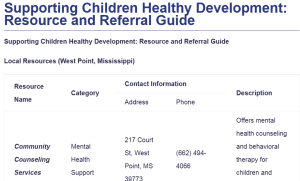Supporting Children Healthy Development: Resource and Referral Guide
Local Resources (West Point, Mississippi)
| Resource Name | Category | Contact Information | Description | |
| Address | Phone | |||
| Community Counseling Services | Mental Health Support | 217 Court St, West Point, MS 39773 | (662) 494-4066 | Offers mental health counseling and behavioral therapy for children and families in West Point |
| West Point Family Resource Center | Parenting Help | 610 Commerce St, West Point, MS 39773 | (662) 494-1413 | Provides parenting workshops, support groups, and referrals to local and regional services for family and child well-being: Supporting Children Healthy Development: Resource and Referral Guide |
| Mississippi Early Intervention Program (IDEA Part C) | Early Intervention | MSDH Central Office
570 East Woodrow Wilson Drive Jackson, MS 39216 |
601‑576‑7400 (8am-5pm) | Focuses on supporting infants and toddlers with developmental delays through home-based services, therapies, and family support |
National Resources
| Resource Name | Category | Contact Information | Description |
| National Association for the Education of Young Children (NAEYC) | Education and Development | Website: https://www.naeyc.org/our-work/initiatives/profession | Provides tools, research, and professional development for educators and families to support young children’s development and learning (NAEYC, n.d.). |
| Child Mind Institute | Mental Health Support | Website: https://childmind.org/ | Offers resources for understanding and addressing children’s mental health issues, including free guides, videos, and parenting tips |
| National Parent Helpline | Parenting Support | Phone: 1-855-4A-PARENT (1-855-427-2736) | Provides confidential emotional support for parents and caregivers, with trained advocates to connect families to local resources |
Online Tools
| Resource Name | Category | Contact Information | Description |
| PBS Kids Apps | Online Learning | Website: https://pbskids.org/apps | Features interactive games and activities promoting social-emotional development for children |
| Calm App for Kids | Emotional Regulation | Website: https://www.calm.com/app | Offers mindfulness exercises, guided meditations, and bedtime stories for children and families to improve emotional well-being. |
Reflection
This guide is valuable in my teaching practice as it streamlines access to essential resources for managing children’s social, emotional, and behavioral challenges. It equips me with a comprehensive list of local, national, and online resources that can be quickly referenced during parent-teacher conferences, classroom interventions, or collaborative problem-solving sessions. By having this guide readily available, I can support children holistically, addressing not just academic needs but also the social and emotional factors that influence their learning.
Additionally, it fosters effective communication with families by demonstrating awareness of community support, which builds trust and strengthens partnerships. In moments of urgency, such as when a child exhibits concerning behaviors, this guide ensures I can act promptly and refer families to the appropriate services.
IDEA Part C or the Mississippi Early Intervention Program may be the most beneficial to work with families. I can also use it to monitor and offer developmental intervention long before a problem becomes unmanageable due to the focus that it affords me in identifying early signs of developmental delays in children that I work closely with and their families. The ideally designed and developed family-centered program makes all the caregivers full of power and information during the intervention. I can ensure families get connected to this resource and that they get therapies and services on time that fit the needs of their child, hence promoting partnership.
While the guide is comprehensive, additional resources focusing on culturally responsive practices and language-specific support for non-English-speaking families are needed. Resources that address trauma-informed care would also be valuable, as many children face adverse experiences that affect their behavior and learning. These additions would ensure inclusivity and a more robust support system for all families in the community.
References
Kostelnik, M. J., Soderman, A. K., Whiren, A. P., & Rupiper, M. (2016). Guiding children’s social development and learning. Cengage Learning.
NAEYC. (n.d.). Power to the Profession. https://www.naeyc.org/our-work/initiatives/profession
ORDER A PLAGIARISM-FREE PAPER HERE
We’ll write everything from scratch
Question 
Assignment: Creating a Personalized Parent/Teacher Resource and Referral Guide
Objective:
Students will research and create a resource and referral guide tailored to their community or region, focusing on understanding and managing children’s behaviors. This guide will serve as a practical tool for teachers to use in real-life classroom scenarios and when collaborating with families.
Book: Yuzu Reader: Guiding Children’s Social Development and Learning: Theory and Skills or Yuzu Reader: Guiding Children’s Social Development and Learning: Theory and Skills

Supporting Children Healthy Development: Resource and Referral Guide
Assignment Instructions
- Research Local and National Resources:
Identify8 resources that support the social, emotional, and behavioral development of children. These resources should include a mix of:- Local resources(e.g., early intervention programs, community mental health services, parent support hotlines).
- National resources(e.g., evidence-based websites, hotlines, or organizations).
- Online tools(e.g., podcasts, apps, or educational videos).
- Information to Include for Each Resource:
For each resource, provide:- Resource Name
- Category(e.g., Early Intervention, Mental Health Support, Parenting Help)
- Contact Information(e.g., phone numbers, websites, addresses)
- Descriptionof the services or support offered (2-3 sentences).
- Create a Guide:
Organize the information into a visually appealing, easy-to-use one-page graphic or document. Your guide should be teacher-friendly and include:- A titlethat reflects the purpose of the guide (e.g., “Managing Children’s Behaviors: A Quick Resource Guide”).
- Sectionsbased on categories of resources.
- A design element(e.g., a logo, icons, or formatting that makes the guide clear and professional).
- Reflection Questions (Short Responses):
After completing your guide, answer the following questions in 1-2 paragraphs (300 words):- How can this guide help you in your future teaching practice?
- Which resource do you think will be the most helpful for collaborating with families, and why?
- What resources do you think you still might need?
- Submission Details:
- Submit your one to two page guide as a PDF or Word document.
- Include your reflection responses in the same document.